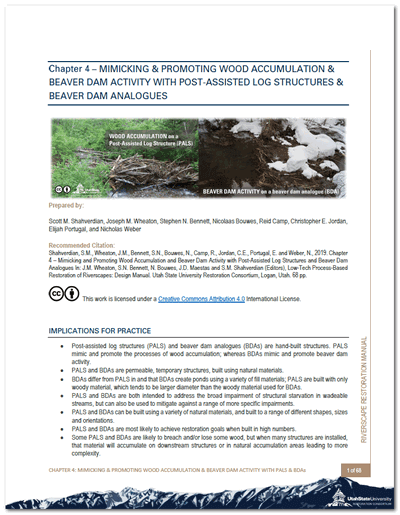4. PALS and BDAs
Chapter 4: Mimicking and Promoting Wood Accumulation and Beaver Dam Activity with Post-Assisted Log Structures and Beaver Dam Analogues
The fourth chapter is meant to be the authoritative reference on two low-tech restoration techniques that are lacking guidelines in the literature: post-assisted log structures (PALS) and beaver dam analogues (BDAs). It helps readers understand what PALS and BDAs are, how they are used in low-tech restoration design, and focuses on the processes initially mimicked, later promoted, and eventually self-sustaining — namely wood accumulation and beaver dam activity.
Chapter 4 also has appendices on:
- Appendix A: Frequently Asked Questions About PALS and BDAs
- Appendix B: Low-Tech Process-Based Restoration Semantics
- Appendix C: Recent History of Beaver Dam Analogues
- Appendix D: Typical Schematics and General Suggestions for Placement and Construction of PALS
- Appendix E: Typical Schematics and General Suggestions for Placement and Construction of BDAs
Full PDF available for free at ResearchGate, but requires a free account.
Implications for Practice
- Post-assisted log structures (PALS) and beaver dam analogues (BDAs) are hand-built structures.
- PALS mimic and promote the processes of wood accumulation; BDAs mimic and promote beaver dam activity.
- PALS and BDAs are permeable, temporary structures, built using natural materials.
- BDAs create ponds with various fill materials; PALS use only woody material, usually of larger diameter.

- PALS and BDAs address structural starvation in wadeable streams, but can also help with more specific impairments.
- They can be built in various shapes, sizes, and orientations using local materials.
- Best results come from building many structures, increasing complexity.
- Some PALS or BDAs may breach or lose material, but this material usually gets trapped downstream, increasing diversity.
Recommended Citation
Shahverdian, S.M., Wheaton, J.M., Bennett, S.N., Bouwes, N., Camp, R., Jordan, C.E., Portugal, E., and Weber, N. 2019.
Chapter 4 – Mimicking and Promoting Wood Accumulation and Beaver Dam Activity with Post-Assisted Log Structures and Beaver Dam Analogues.
In: J.M. Wheaton, S.N. Bennett, N. Bouwes, J.D. Maestas, and S.M. Shahverdian (Editors), Low-Tech Process-Based Restoration of Riverscapes: Design Manual.
Utah State University Wheaton Restoration Consortium, Logan, Utah. 66 pp.
DOI: 10.13140/RG.2.2.22526.64324
Related Resources
👉 Post-Assisted Log Structure Recipes
👉 Ask a Question to the Community
Chapter Four Figures
All original figures downloadable and citeable with DOI:
10.6084/m9.figshare.14445519.v1
